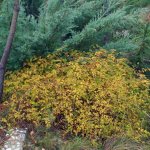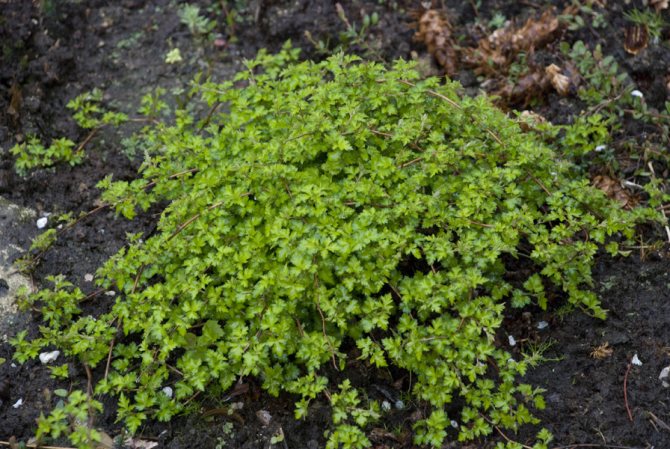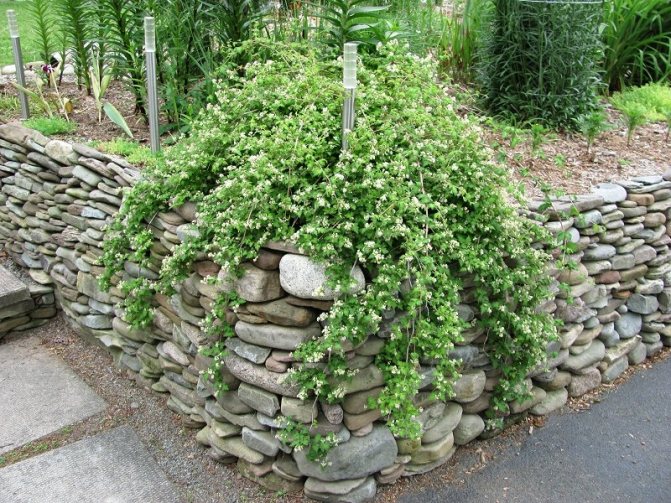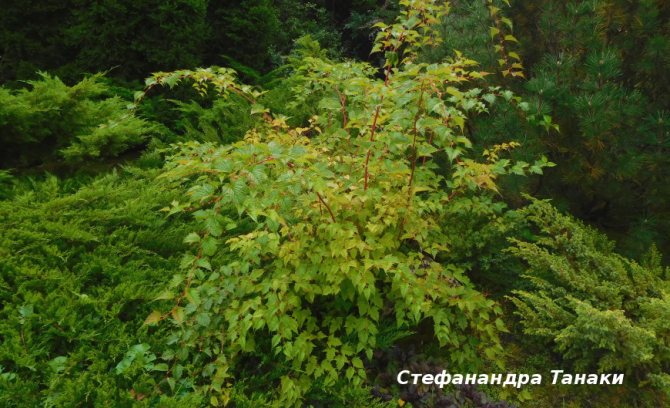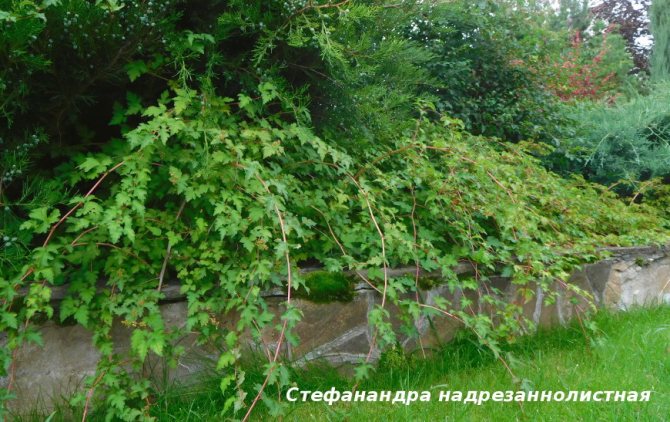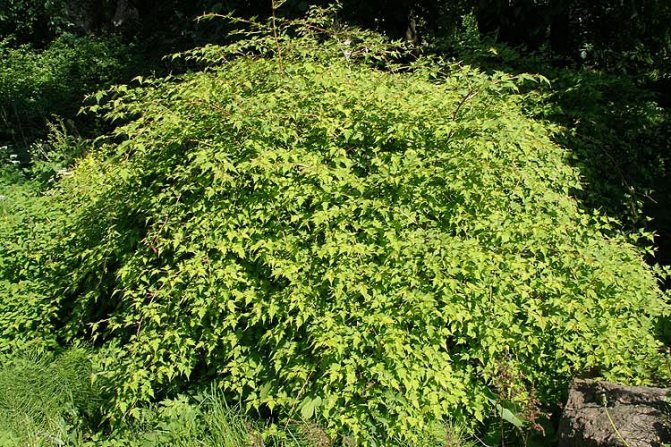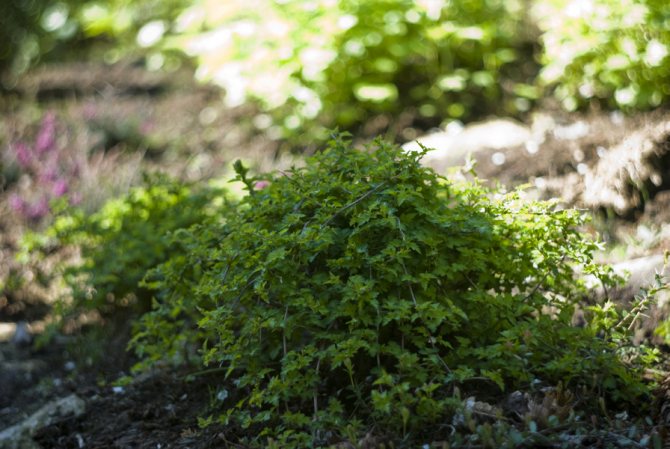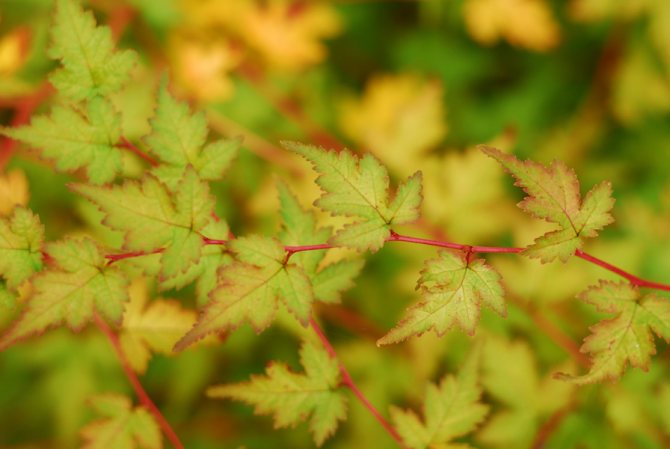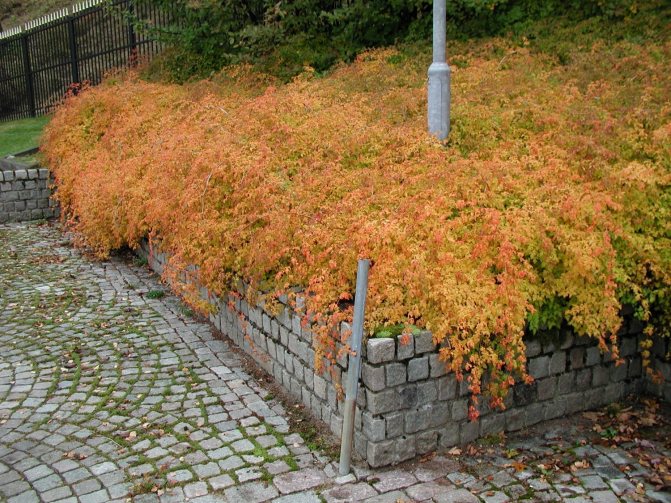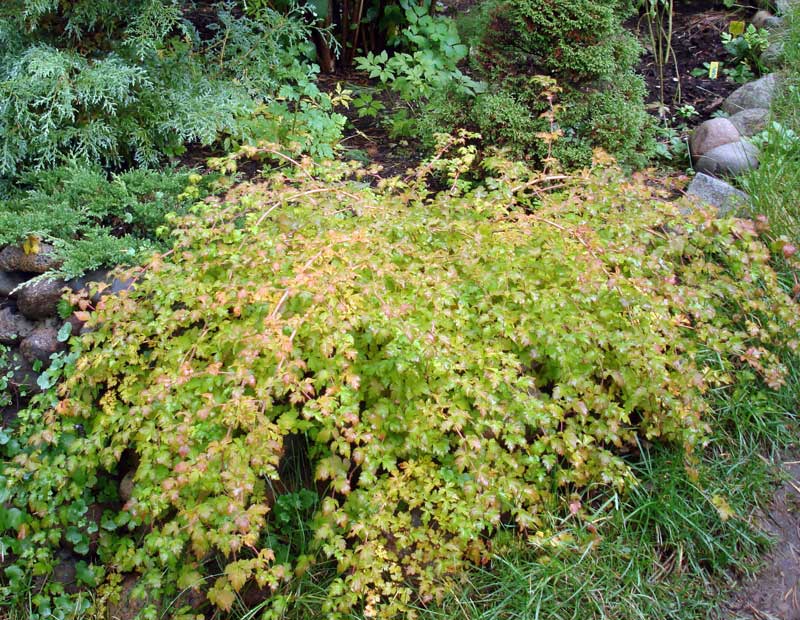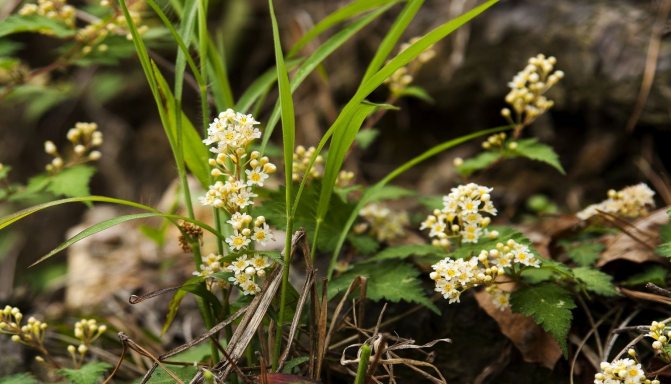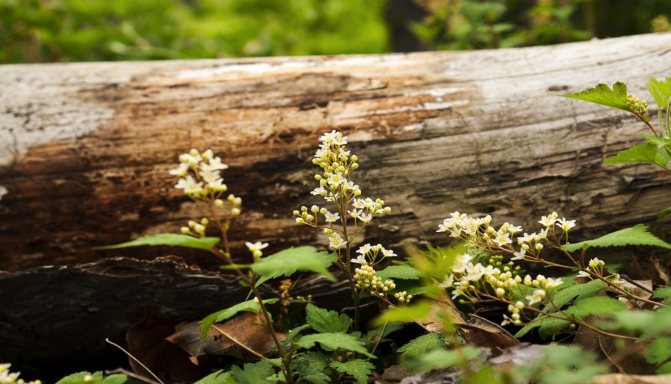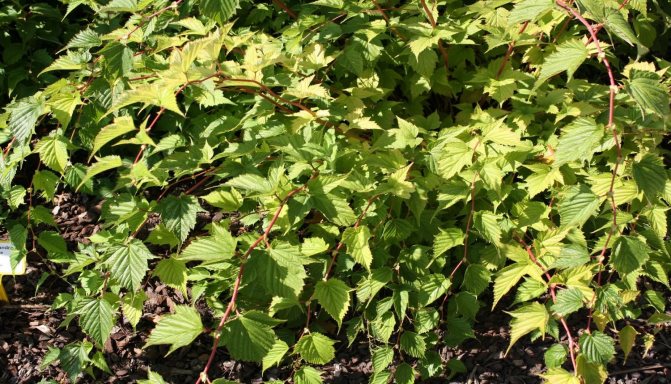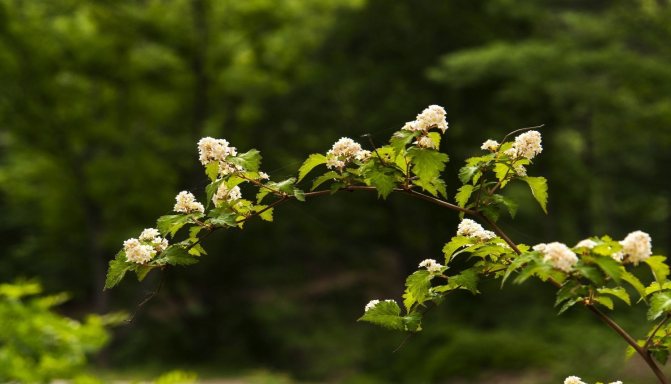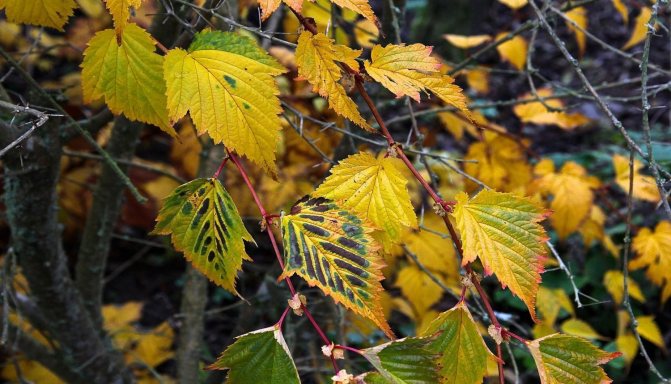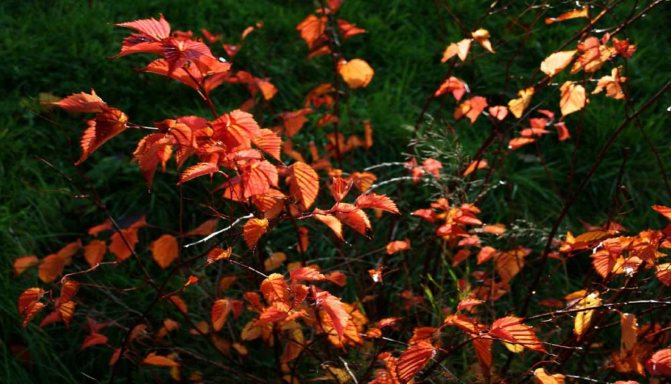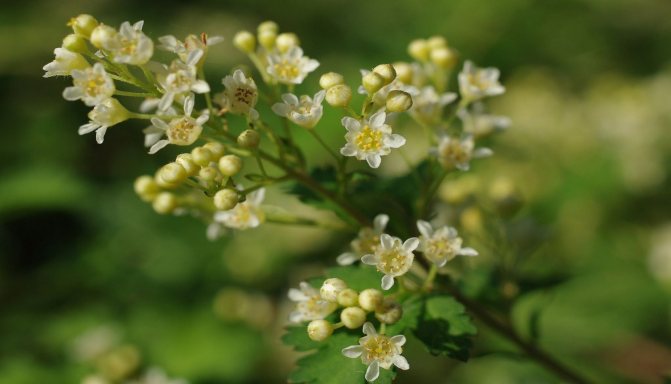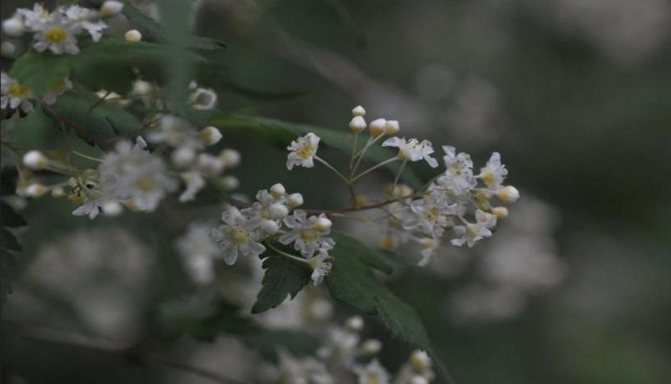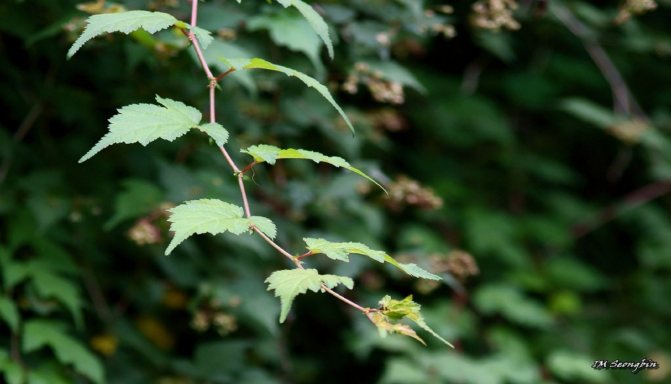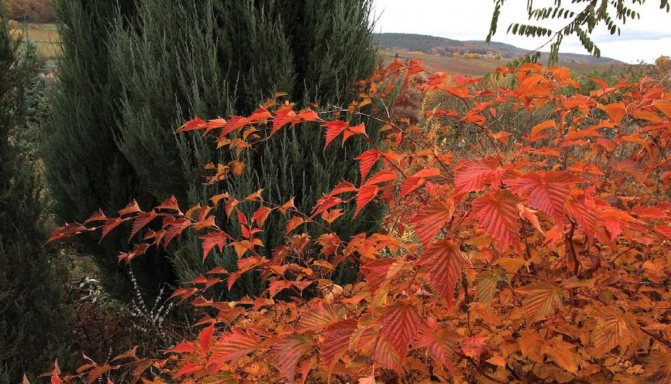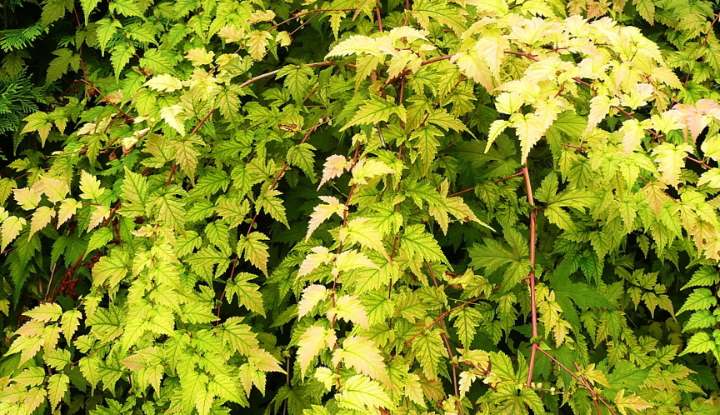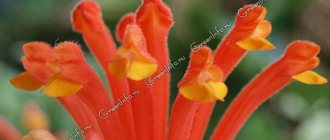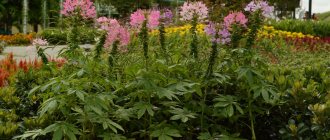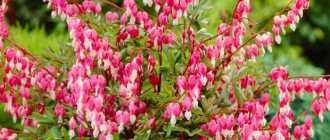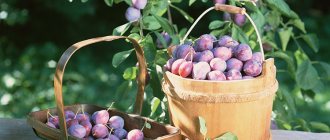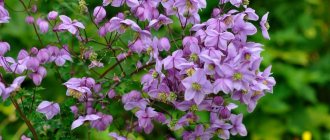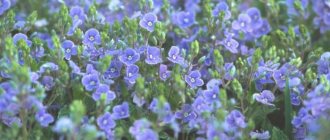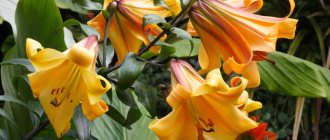Interesting! In the flower of Stephanandra, the stamens are arranged in a circle - this was the reason that Stephanandra received the second name "male wreath".
Types and varieties
In our country, two species of this genus are widespread: Stephanandra notched-leaved and Stephanandra Tanake.
Incised
This species is a shrub with drooping branches, the height of which can reach two or more meters. However, Stephanandra will reach such growth at a venerable age, usually the bush rarely exceeds a meter. Her leaves are dissected, turn red in the fall. They are located in the same plane, which gives the twigs the appearance of bird feathers.
Stefanandra notched-leaved blooms from mid-May to mid-June in small greenish-white flowers with a pleasant mild aroma.
Stefanandra incised-leaved
Crisp
One of the varieties of stefanandra incised-leaved is the dwarf form of Crisp. It is a wide thicket up to half a meter high and about
Two meters in diameter. Many flexible shoots and twigs intertwined with each other form a continuous cover, as if a thick feather bed or a large green pillow were lying on the ground.
Stefanandra Crispa often reproduces by itself, her shoots lying on the ground take root on their own, making the "pillow" even more luxuriant.
Tanaka
Stephanander Tanake's species is named after the Japanese botanist-gardener Yoshio Tanake. According to the poetic Japanese, the first specimen of this variety was found not just anywhere, but at the foot of Fujiyama.
I immediately wanted to compose a small hokku or haiku:
"On the red line
Beautiful green leaf.
Stefanandra ".
This variety also has a taller bush, up to two meters, and the leaves are larger and whole, thick veins and a slightly wrinkled surface give them decorative effect.
The Japanese variety blooms later than usual: in July-August with small white buds up to five millimeters in diameter. Stephanandra Tanake is especially decorative in autumn.
The shoots of Tanake are thicker than those of the incised-leaved species, so the branches do not hang. and the plant itself has a more austere and upward bush.
Stefanandra Tanake is not very hardy, often shoots that are above the snow cover freeze slightly in winter. This is not scary, since the plant quickly recovers after sanitary pruning, but it is still advisable to bend the branches to the ground for the winter.
Stefanandra: features
Stefanandra incised-leaved has medium frost resistance and can freeze under severe winters, but the plant recovers very quickly and easily.
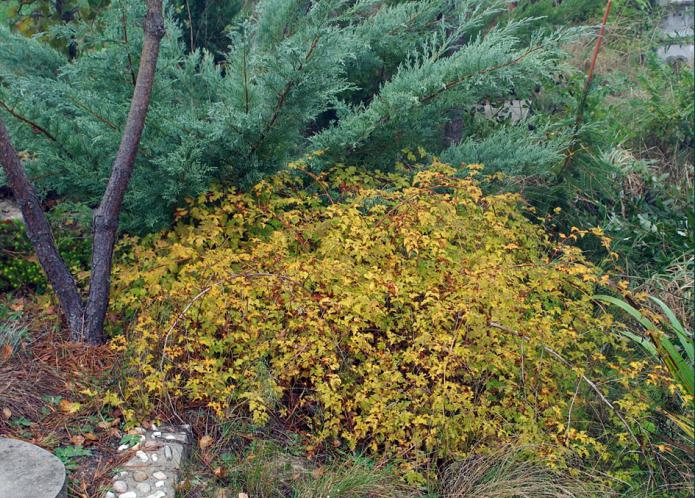
Therefore, for the winter period, it is recommended to cover the base of the plant with peat or a dry leaf, from which the root collar of the bush must be freed in the spring.
Stefanandra notched-leaved is intended for single plantings, planting in decorative groups and on retaining walls, grows well in the sun, but semi-shaded places protected from piercing winds are optimal for it. The openwork carpet of the bush, formed by the green crown of the plant, under the trees with light leaves, looks harmoniously.
Agrotechnics
Planting and subsequent care for Stephanandra notched-leaved and Tanaka are not at all difficult and can be done by any gardener or summer resident.
Reproduction
Reproduction of Stefanandra is carried out in various ways, both seed and vegetative.
With the seed method, the seeds do not even need to be stratified; collected in the fall, you can immediately sow on the garden bed. Stephanandria Crispus has the only limitation in seed propagation. This hybrid form does not retain parental traits in the seeds.
This plant reproduces well both green and lignified cuttings. Moreover, if an incised-leaved species has a survival rate of one hundred percent, then it is advisable to pre-process the cuttings of Tanaka as part of some kind of root formation stimulant.
It is also easy to propagate Stefanandra with side layers. Shoots pinned to the ground should be sprinkled with soil and watered, you don't even need to remove a piece of bark, so well the plant is able to form roots itself.
Or you can do it quite radically - dig out part of the bush from the side and transplant it to a new place, Stephanandra will take root perfectly.
Landing
Despite the fact that this plant tolerates partial shade well, it is still better to plant it in a sunny place protected from northern winds. The soil at the planting site should have a neutral reaction and be breathable on one side and at the same time constantly moisturized. Such conditions are provided by the correct filling of the landing pit.
Firstly, gravel and sand must be placed on the bottom of the pit. Secondly, the pit is filled with nutritious soil. Thirdly, it is imperative to mulch the plantings to avoid drying out the soil.
Attention! Proper mulching will protect your plants from both waterlogging and drying out of the soil. In addition, mulch provides food for microorganisms, the products of which are processed by plants. It is especially important to carry out mulching on fast-drying sandy soils.
The best time to plant Stephanandra is spring.
Care
Stefanandra's care consists in carrying out regular sanitary and rejuvenating pruning, watering and feeding.
Sanitary pruning is carried out in early spring, when all frost-bitten and snow-broken shoots are cut out. Branches that grow strongly in the sides and spoil the appearance of the shrub are also shortened.
Anti-aging pruning is carried out on plants over four to five years old. At the same time, all old shoots are cut out on the ring at the root.
Stephanandra irrigates regularly, depending on the weather. In dry periods, watering is carried out once a week or two, pouring 10-20 liters under the bush. Partially reducing water consumption allows high, up to ten centimeters, mulching.
Stefanandra is fertilized twice every year. The first feeding is carried out in early spring. At the same time, manure, humus or compost is scattered under the bushes, which is then covered with a layer of mulch. Rotting under the mulch layer, fertilizers provide food to soil organisms.
The second time feeding is applied in the middle of summer. At this time, water infusions of mullein, chicken droppings or herbs are used in the following proportions:
- mullein - 1:10;
- chicken droppings - 1:20;
- infusion of weeds 1:10.
Shelter for the winter
This technique is especially needed, as mentioned above, by Stephanandra Tanake, but this action will help to preserve the notched-leaved look.
To save the bush from severe frosts, you just have to bend the branches to the ground and tie them together with twine so that the height of the bent bushes does not exceed half a meter. Falling snow will complete Stefanandra's shelters.
Finally, we recommend that you watch an interesting video sequence about this plant, in which you will see various options for the location of Stephanandra in an ornamental garden.
Happy Admin (Administrator) Moscow, Russia, on the site since 11.01.2017
Stefanandra - the name translated from Greek means "male wreath", this is due to the circular arrangement of the shoots and stamens on the flowers. The decorative value is no longer the flowers, but the curly, graceful shoots, which become a real highlight of any garden.
Growing in a personal plot
This is an undemanding ornamental crop that grows with equal success on sandy and poor organic soils, can be planted in the shade and in sunny areas. Providing the shrub with the simplest care, it will be possible to guarantee excellent decorative effect and rapid growth of the planted bushes.
Growing asparagus pinnate at home and caring for it
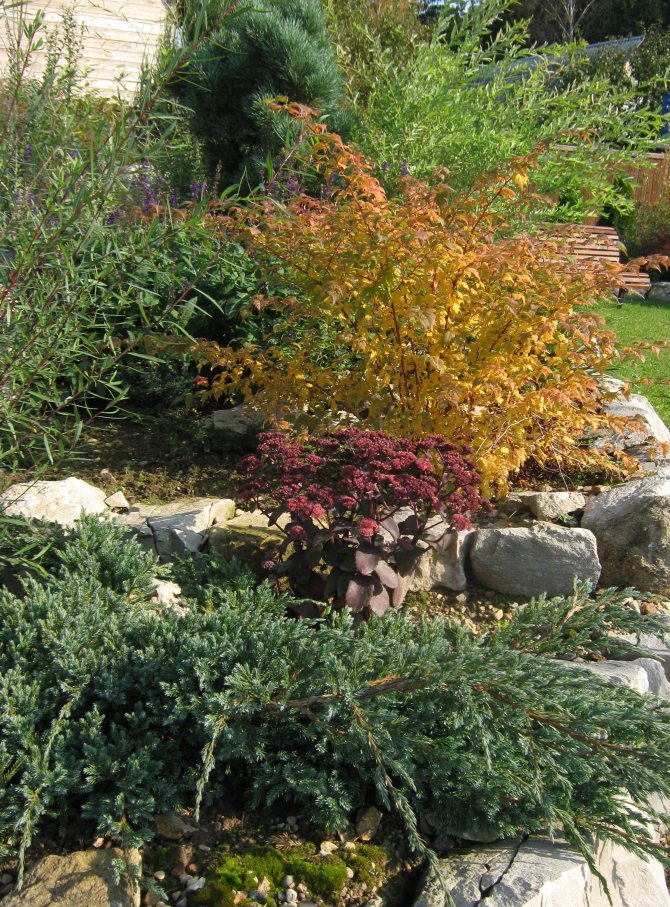

Stefanandra shrub prefers well-moistened, loose and fertile soil. Best of all, this ornamental culture grows on sandy-peat substrates. Planting in clay and loamy soils is also possible. But heavy clay soil should be mixed additionally with peat and sand. The best soil acidity is slightly acidic and neutral... With a high level of groundwater, it is necessary to take care of high-quality drainage, for which large crushed stone, broken brick, and gravel are laid in the planting pit.
Best of all, the Stefanandra plant develops in areas well-lit by the sun. But in the shade and partial shade, the bush grows slowly, there are certain problems with flowering. Therefore, the gardener should choose the right site for planting this plant, which in the future will eliminate the need to transplant already adult shrubs, which after such a procedure are sick for a long time and lose their decorative effect.
Planting seedlings
You can plant Stefanandra in your garden with seeds and cuttings. It is necessary to purchase seeds in specialized stores, which will allow you to be sure of the variety of planted ornamental shrubs. The seeds will not require stratification or any additional preparation. They are planted in a fertile light substrate in early May, when the danger of frost has already passed. Additionally, it is recommended to add wood ash to the ground, provide seedlings with moderate watering and subsequently thin out the seedlings.
It is also possible to propagate this ornamental shrub with the help of cuttings, which are cut from plants in summer, after which they quickly take root in fertile soil. Stefanandra can be propagated by cuttings in spring and autumn. In the event that such work is carried out in the fall, it is necessary to additionally mulch the soil with peat or other organic matter, which will allow the seedling to take root and protect the young plant from the cold in the winter season.
Cutting of Stefanandra is carried out as follows:
- One-two-year-old stems are cut from a healthy bush.
- The cuttings are kept in growth stimulants for 5-7 hours, after which they are planted in containers with fertile soil.
- Young plants are watered and covered with foil to create greenhouse conditions.
- The soil in the container is regularly moistened, and the plants are ventilated. In such conditions, after 3-4 months, the plants will have roots, after which the grown seedlings can be transplanted into open ground.
Care and planting of the apical pachisandra
When planting seedlings and rooted cuttings, the minimum distance between shrubs should be observed, which is at least three meters.
These are large-sized ornamental plants, therefore, with an excessively dense planting, Stephanander will grow poorly, lose the splendor of the crown and will be susceptible to various bacterial and infectious diseases.
Correct care
Caring for Stephanandra is not particularly difficult, so every gardener and owner of a private house can handle such work.
Growing shrubs will need to provide the following:
- Timely watering.
- Pruning the crown.
- Top dressing with fertilizers.
- Warming for the winter.
Stefanandra is a moisture-loving plant, and with a lack of moisture, decorativeness deteriorates significantly, the foliage quickly turns yellow, and the shrub itself may soon die. Ideally, Stefanandra should be watered twice a week. The gardener will need to monitor the soil moisture indicators and the condition of the plant. In hot and dry weather, watering should be intensified, preventing the soil from drying out. After each watering, the soil should be slightly loosened, which will improve the saturation of the root system with oxygen.
Crown pruning is carried out in the spring even before the appearance of buds and sap flow. Subsequently, after the flowering phase, sanitary pruning is allowed, in which dried and damaged shoots are removed. To form the correct crown, it is necessary to remove damaged branches, avoiding thickening of the shoots, leave several main skeletal branches, the number of which should not exceed 5-6 strong branches.
The grower will need to control the number of lateral basal processes, which can grow rapidly, taking away some of the nutrition from the mother plant. Such lateral basal processes should be removed, if possible, by performing such work in the spring or autumn after the foliage has fallen.
It is possible to achieve the maximum possible decorative effect and rapid growth rates by only performing timely feeding of Stefanandra. In the spring, nutritious mineral compounds with a high nitrogen content are introduced into the soil. You can feed Stefanandra organics, including chicken droppings and humus. Such an organic mixture is introduced exclusively under the root, preventing the solution from getting on the foliage.
Growing tobacco at home from seeds and in the garden
In autumn, mineral fertilizers with phosphorus and potassium are used, which will allow the plant to prepare for winter. Without such autumn dressing, the plants weaken over the winter, and subsequently their decorative effect deteriorates significantly, numerous diseases appear, and the shrub soon dies.
Before the very cold weather, it is necessary to carry out sanitary pruning, remove fallen leaves, mulch the soil with sawdust, and it is advisable to cover young bushes with spruce branches or other heat-insulating materials. It will not be superfluous to wrap the shrub with roofing material, which will solve the problem with rodents, which in winter like to feast on delicate bark and young shoots.
Description of Stephanandra
This deciduous perennial shrub belongs to the Rosaceae family. Originally from East Asia, it is especially common in Japan and Korea. An adult, spreading shrub reaches dimensions up to 2.5 m in width and height, but the annual growth is small. Decorative shoots, taking the shape of an arc under their own weight, create an elegant crown.
Young branches are colored reddish brown. Leaves are carved, fastened on short petioles alternately. In shape, the leaf plate is ovoid or oval, the ends are pointed. The edges of the leaf can be smooth, with sparse teeth, or strongly dissected. The leaves are painted in a bright light green color, and by autumn they turn yellow and orange.
When does Stephanandra bloom?
The flowering shrub starts in early summer and lasts until August. Small flowers up to 5 mm in diameter gather in inflorescences not densely.The petals are pointed, white in color, located around a spherical yellow core. The aroma of flowers is pleasant, not intense. In September-October, small leafy fruits with small spherical seeds begin to ripen. One ovary contains a pair of seeds. When the fruit is ripe, it will open and the seeds will begin to fall out.
Interesting notes for gardeners about Stephanandra
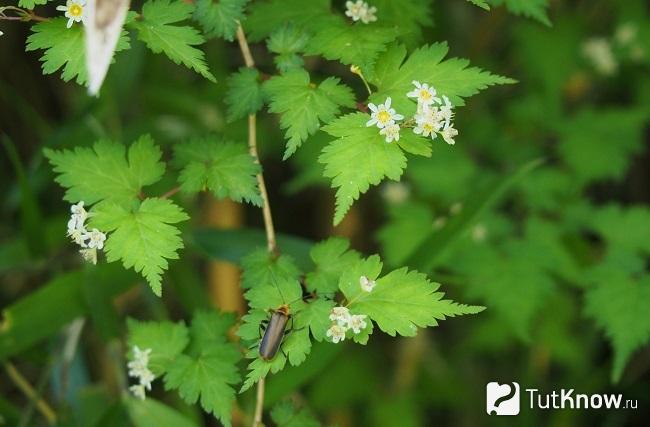

The Stephanandra bush is very similar in shape and flowering to the Spiraea, which is a member of the same Rosaceae family. However, the flowering of the latter is more lush and fragrant. As a decorative and landscape gardening culture, the "male wreath" began to be grown in Europe and the United States only at the end of the 19th century. The plant, with its simplicity and spectacular crown, quickly won the hearts of gardeners, and it became not such a rarity in our lands.
Growing Stefanandra from seed
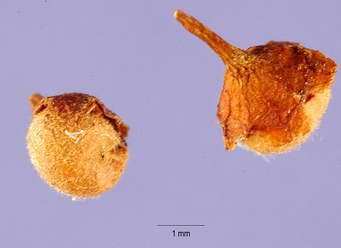

Stefanandra seeds photo
Stefanandra propagates by seeds and cuttings.
Seeds do not need pre-treatment before planting. It is better to plant them directly in open ground from the middle of spring. It can be sown on seedlings, but in order for the roots to get strong enough, the transplant can be done no earlier than the seedling reaches 6 months.
- The seeding depth is 1-2 cm.
- It is better to plant in separate cups, preferably tofy ones, so that when planting in the ground, it does not disturb the roots.
- Grow your seedlings in a sunny window with good light.
- Water sparingly as the substrate dries. Drain excess water from the sump.
- Six months after sowing, the seedlings can be planted in a permanent place, having previously hardened it for two weeks.
Landing in the ground
Loosen and fertilize the soil well before planting, immediately start drainage with gravel, pebbles, brick chips or coarse sand. If the soil is clayey, heavy, planting holes should be covered with a sand-peat mixture. Maintain a distance of at least 1.5 m between the bushes, otherwise the plants will be cramped. Cover the top layer with a deciduous substrate. Water the bushes sparingly to keep the roots from pulling out.
How to care for Stefanandra outdoors
Seat selection
Choose a sunny area for the plant, only slight shading is allowed. The shrub will grow well on fertile soils, light sand-peat mixtures are preferred, but can be planted on loam or clay soils, providing good drainage.
Watering
Water often and abundantly. Pour about two buckets under one bush every 1-2 days. During precipitation, watering is reduced. Keep a balance so that the rhizome does not start to rot; the soil should have time to dry out between waterings. The appearance of the plant will indicate a lack of moisture: the leaves will begin to droop and dry.
Varieties of Stefanandra
Two types of Stefanandra are cultivated culturally: incised-leaved and Stefanadra Tanaka.
Stefanadra incised-leaved stephanandra incisa
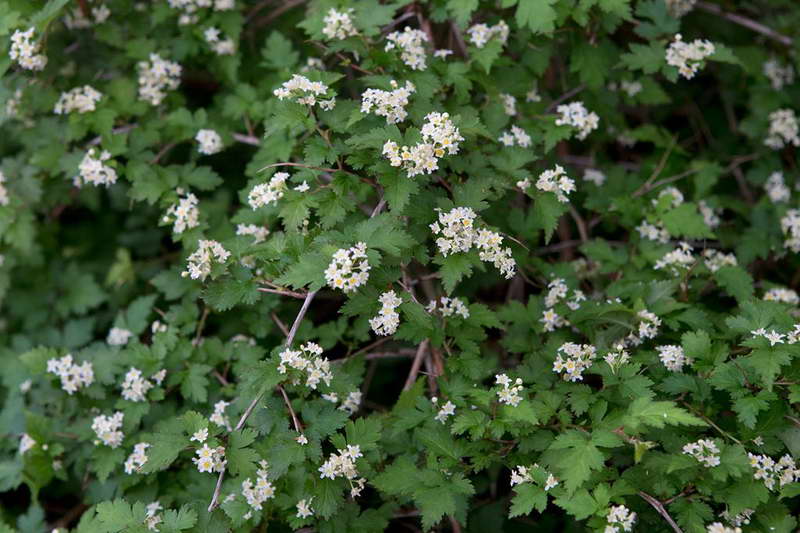

Stephanandra incisa crispa photo
The shrub reaches a height of 1.5-2 m, and a width of 2-2.5 m, but it grows slowly and can gain the indicated dimensions by the age of 25-30 years. Castings are openwork, deeply dissected, located on short petioles on both sides in the same plane from the branch, like a fern, which increases the decorative effect. The bushes are especially elegant in autumn, when the foliage acquires a brownish-red hue. From the end of May, the plant begins to become covered with small flowers exuding a delicate aroma. The petals are greenish, the inflorescences do not have a special decorative effect, but they give the bush some charm. Flowering lasts a month.
Crispa is a botanized variety of Stephanandra notched-leaved. The bush is dwarf. On average, the height of the plant is 50-60 cm, and the width is about 2 m. The shoots are intertwined, bent in an arc, forming an opaque solid crown, which creates the appearance of a thick pillow or pouf.The leaves are even more dissected with a wavy or folded structure. In autumn, the color becomes interesting, heterogeneous in the form of red-brown, orange and yellow spots. Flowering is identical to the original species.
Stephanandra Tanaka or Tanake Stephanandra tanakae
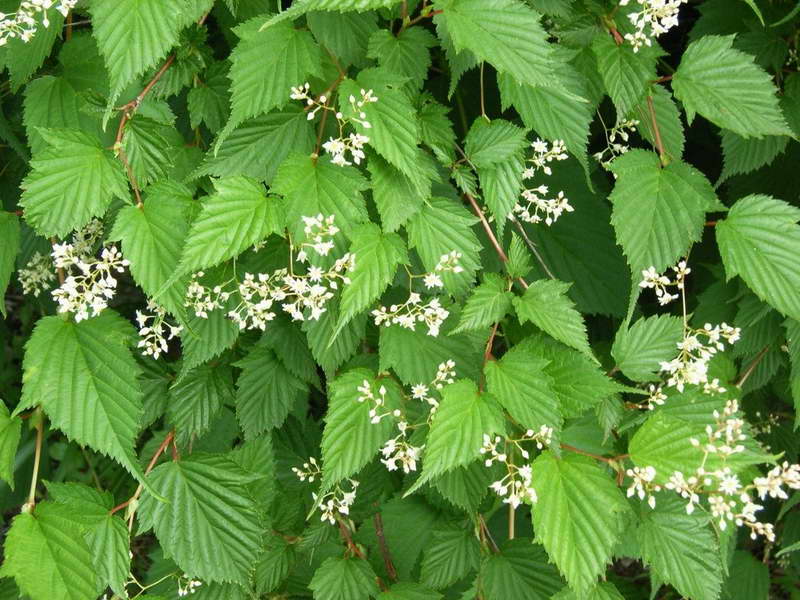

Stephanandra Tanaki or Tanake Stephanandra tanakae photo
An adult shrub reaches a width of 2.5 and a height of about 2 m. The leaves are much larger: they are attached separately on petioles up to 1.5 cm long, and themselves reach a length of about 10 cm. The leaves are heart-shaped, pointed, with double-serrate edges. Below the veins are covered with sparse down. In autumn, the leaves take on brown, purple, burgundy hues. Inflorescences are also larger, up to 10 cm in diameter. Flowering lasts from July to August. The petals are creamy green in color, the middle is yellow with filamentous stamens. The branches of young plants are covered with burgundy-brown bark, and over the years it becomes light brown, gray.
Stefanandra as an ornamental plant
Stefanandra notched-leaved Crispa, reviews of gardeners about which are positive and cause a desire to acquire such an unusual ornamental plant, is used to create complex decorative compositions and group lawn plantings.
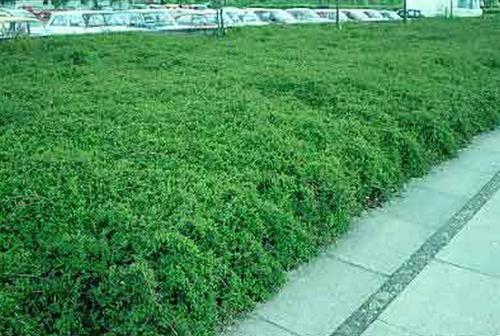

Even in its proud and such contrasting solitude, the bush attracts the interested glances of passers-by. The plant looks spectacular against the background of evergreen shrubs and conifers.
Stefanandra species
At home, two types of this unusual plant are bred.
- Stefanandra is incised-leaved. More than a hundred years ago, the shrub was introduced from Japan. This variety of stefanandra has a beautiful openwork crown. In conditions of natural growth, the height of the incised-leaved stefanandra is up to three meters, at home the shrub grows up to one and a half meters. The plant is distinguished by long, thin, almost weightless, openwork shoots, the bark of which is colored brownish-red. Leaves of stefanandra notched-leaved, elongated, oval, pointed to the tip and widened near the base. Leaves located on sterile shoots have a slightly different structure. They are large, lobed and serrated. On the underside, the leaf plate is pubescent. Stefanandra notched-leaved blooms in June with small white flowers with a greenish tinge, collected in panicle inflorescences, which are located at the ends of the branches. At the end of summer, fruits ripen on the bush, in which there are 2 round seeds.
- A variation of this variety is Stefanandra crispa, which is a dwarf bush form. The height of an adult plant does not exceed 80 centimeters, and the width of the spreading crown can reach one and a half meters. Most often, landscape designers use this variety as a ground cover plant. The crown of Stephanandra notched-leaved crisp is very dense, formed as a result of a strong interweaving of shoots. The leaves are strongly dissected and have wavy edges. The shrub is very beautiful in autumn, when its foliage is painted in all shades of red.
- Stefanandra Tanaka is a shrub two meters high with a crown that can be up to three meters wide. Stefanandra Tanaka's flowers are small white, effectively cover the entire shrub during the flowering period. Stefanandra Tanaka is widespread in Southeast Asia. In Japan, the plant is often planted around the house.
How to play effectively in the garden?
Stefanandra will not please with bright blooms, but her lush waterfalls of branches are suitable for decorating the slopes or banks of a small pond. Light greens work well with dark foliage of trees or other shrubs. In autumn, the contrast of orange-red foliage with conifers and evergreens is beautiful.
Stefanandra is best used as a solitaire or in central positions in a flower garden. In spring and summer, they form a delicate backdrop for brightly blooming summer plants.
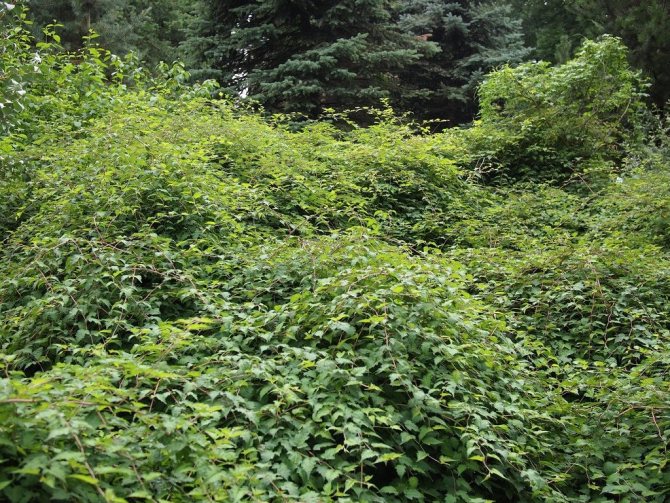

A low-growing crisp can effectively cover the lawn, like ground cover varieties. The high waves of perennials will make a wonderful hedge, especially if there is a busy road nearby and you need to absorb the noise from the emissions. All varieties are suitable for urban or park landscaping, they look beautiful in the mixborders in the foreground.
Plant care at home
Caring for the plant is easy, since the shrub is unpretentious and unpretentious. In order for Stephanandra to please with an attractive appearance, it is necessary to create conditions close to natural.
Lighting and location
Stefanandra responds very well to diffused lighting and loves partial shade. The west and southwest sides of the garden area are well suited for its cultivation. In the hot season at noon on the south side, the plant will need a little shade for 2-3 hours. After cloudy weather or lack of light, they gradually accustom themselves to bright light. This is to avoid burning the leaves.
The shrub tolerates polluted air and gas pollution, therefore it is often used for landscaping areas in large cities.
Temperature
Stefanandra's growing season lasts from early spring to mid-autumn. The optimum temperature for active growth and development of the plant is 20-25 degrees.
Watering plants and moisture
During the growing season, Stephanandra needs frequent but moderate watering. It is held early in the morning or late in the evening. Watering is carried out as the top layer of the soil dries up. Then the soil is mulched with sawdust or shavings. Mulch will help prevent moisture from evaporating. Excessive waterlogging or drying of the soil should not be allowed.
Soft warm water is used for irrigation.
Plant transplant and soil
The plant is not demanding on soil and can grow in poor lands. However, in order to maintain the decorative qualities and the normal growth and development of the shrub, a loose nutritious soil should be provided that allows moisture to pass through well.
Pruning
To form a crown, to make it thicker and more bushy, it is necessary to pinch the upper branches. This procedure activates the growth of young shoots and side branches.
Video about the stefanandra bush:
Stefanandra is an ornamental perennial shrub that lovers of exotic plants grow on their backyards. Climbing stems and small fragrant flowers are a real decoration of the plant.
Stephanandra's homeland are the countries of Southeast Asia - Japan, Taiwan, South Korea, China. In European countries and North America, it began to be bred at the end of the 19th century to decorate parks and gardens.
In central Russia, the plant is planted very rarely, since it does not tolerate frost and the cold wind freezes completely. After freezing, the shrub grows very quickly and blooms profusely, so it is grown in areas with mild, windless winters.
Reproduction of Stephanandra
The shrub is propagated in two ways: cuttings and seeds.
- Seed propagation
Seeds are sown in open ground without preliminary preparation. Sowing of seeds is carried out in April. The distance between plantings should be respected so that the seedlings do not have to be thinned out.
It is possible to grow seedlings indoors. But in this case, the plant can be planted on the site only after 6 months. Before planting the plant in a permanent place, you should immediately create a drainage layer of gravel, pebbles and expanded clay. The soil should be light enough, nutritious and breathable. The nutritional composition is prepared from peat, garden soil and sand.
- Propagation by cuttings
Cuttings are cut from the mother plant at the beginning of summer and are planted without pretreatment for rooting on the site.
Some varieties of Stefanandra have a small height and a spreading crown. Very often, when in contact with the soil, the branches take root on their own. In this case, the rooted young plants are separated from the main bush with a pruner or a sharp knife and transplanted to a new place.
Shrub description
Stefanandra's height can be up to two meters. The dwarf form of Crisp, which reaches a maximum of 50-60 centimeters in height, has gained popularity. A distinctive feature of Stefanandra is a fountain-like spreading crown, rich green foliage and numerous snow-white flowers that remain on the bush for a long time. Plants, due to the unusual shape of the crown and densely spaced leaves, look at the same time delicate, light and thick.
In landscape design, Stefanandra can be used as a dominant plant in landscaping, as well as planted in a composition with other ornamental shrubs and various flowers. Such a plant perfectly keeps its shape, accordingly, it is possible, by regular pruning, to form a rounded, spherical, rectangular crown, which in the future does not require any special care.
Ornamental shrub stephanandra: planting and care, photo compositions in the garden
By habit, Stephanandra is a kind of cap, which consists of branched, arched shoots of brown-red color, they spread up to 2.5 meters in width, the same plant can reach a height. The shrub leaves have a shape similar to the shape of currant leaves, they can have both carved and smooth edges, depending on the variety.
The most common species are Tanake and Notched-leaved.
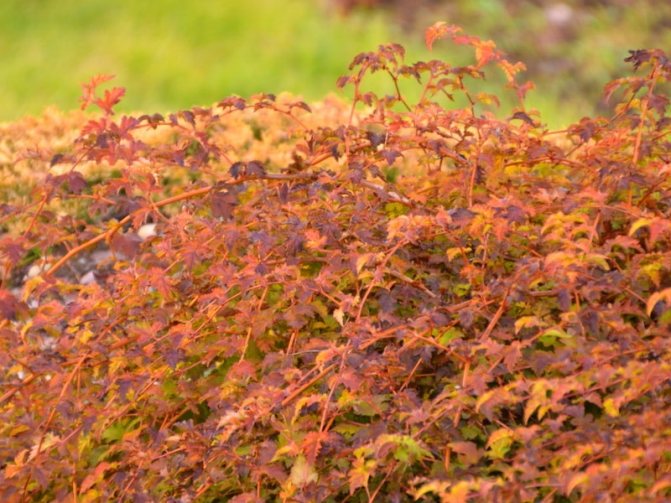

The dwarf variety of incised-leaved stefanandra "Crispa" has a creeping crown and reaches a height of 0.6 m.
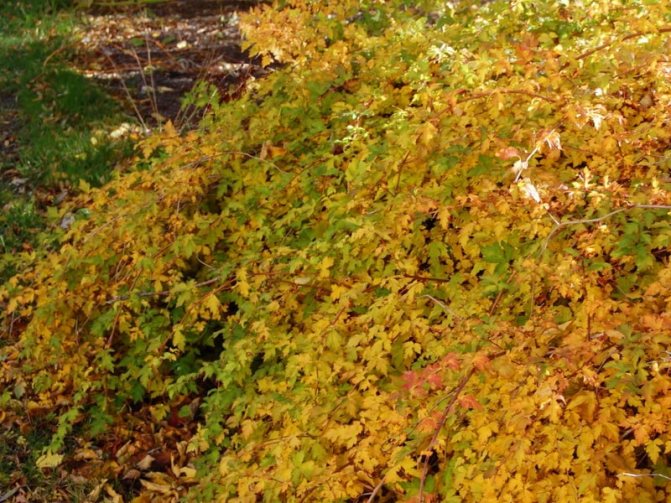

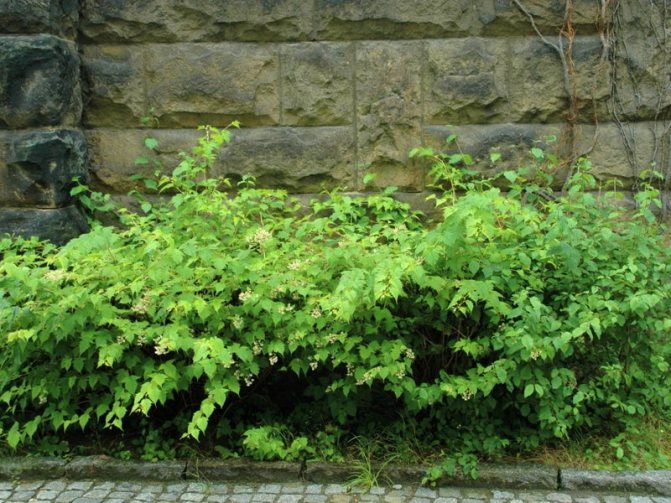

In general, Stefanandra decorates the site well both in summer and autumn, the main thing is that it takes root, and then take proper care of the plant.
How to propagate Stefanandra
Everyone can plant Stefanandra on their site, there is nothing complicated about it. This can be done either with the help of seeds or ready-made seedlings, or with the help of cuttings or layering - but this is in the event that the shrub is already growing on the site, or is available from friends. Stefanandra is considered quite an exotic plant, so its seeds are not so easy to get.
If the seeds of Stephanandra are purchased, the question of the method of cultivation should be resolved - seedling or non-seedling. Many people prefer the latter option. The time for planting seeds in open ground is spring, and it is better to plant at a time when the threat of cold weather has finally disappeared. In this case, the seeds are not threatened to freeze, and they will firmly root in the soil until winter. It is noteworthy that when planting Stefanandra seeds in open ground, no stratification is used.
If you choose the seedling method when planting, then it should be taken into account that the cultivation of seedlings should last at least six months, it is during this time that the plant will strengthen the roots so that it can be safely transplanted to a permanent place.
Cuttings are another great way to grow Stefanandra. In the spring, completely green cuttings are used for this, and in the summer they are semi-freshened. It is especially effective to propagate the shrub with summer cuttings, then the survival rate is 90-100%. Cuttings can be left when pruning the shrub. Usually they take a one-year or two-year-old cutting, one edge should be beveled. It is simply dropped into the ground, without the use of any drugs. The main thing is that the soil meets all the requirements of Stephanandra.
Although it is possible to place the stalk before planting in any store-bought growth promoter and follow the instructions on the package.And after the stalk is stuck in the ground, additionally create a mini-greenhouse for him, using a film or a plastic bottle. Transplanting the cuttings to a permanent place is carried out only next spring.
Another shrub can take root and layering. Often too long shoots of a bush, under their weight, begin to lean to the ground and come into contact with the soil. Then rooting takes place, and absolutely independently. But you can also initiate the process by simply digging in the shoot and watering it. Then, this piece of branch is simply transplanted to another place.
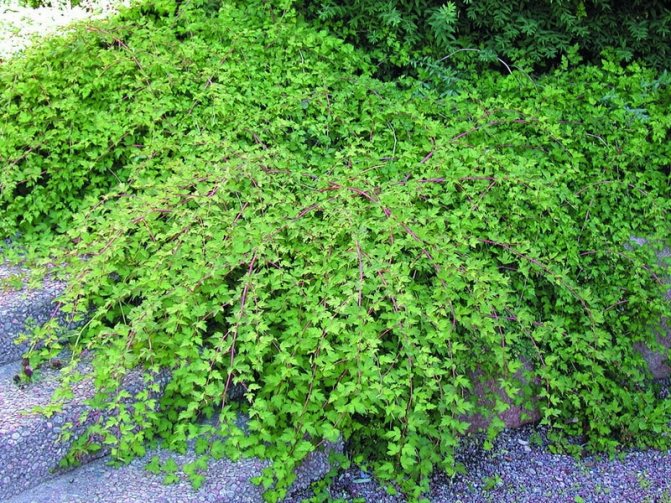

Planting Stefanandra on the site: choosing the right place and preparing the soil
Much attention should be paid to the site and soil for planting Stefanandra. The shrub loves light, so it is better to choose a place for planting it where the rays of the sun constantly fall. Of course, if there is a partial shade nearby, it does not matter either, but it should at least be scattered. Also, the place where Stefanandra will be planted should not be blown by the winds - this is what the plant can die from. Therefore, the shrub should be placed in a protected part of the site.
As for the soil, fertility and lightness are important conditions. In any case, before planting, it must be well loosened, and also leafy soil and peat compost must be added. If the soil is clayey, heavy, then sand and peat must be added to it. In general, the soil for the plant should have a neutral ph. A very important nuance - the shrub will not be able to take root and grow in the absence of drainage.
The first thing to do before planting Stefanandra - it doesn't matter if this planting will be carried out by seeds, seedlings, seedlings, cuttings - is to arrange a drainage system. It should be at least 15 cm, and with heavy clay soils and all 25. Arrange it with pebbles, gravel, broken brick, sand. And only after that comes the layer of earth. The planting pit itself is about 50 cm.In addition to the previously prepared soil, 0.5 cups of wood ash should be added to each pit.
When planting stefanandra, the distance between the seeds (bushes) of 1.5 - 2 meters should be maintained. Of course, it can be cut, but in this case the shrub will have to be thinned out in the future. After planting, the soil is mulched with a deciduous substrate, and mandatory watering is carried out. In the future, the crops are watered often, but in moderation, neither stagnation nor delight should arise.
If a stefanandra seedling is planted, then before placing it in the pit, it must be removed whole with a lump of earth from the container. To do this, the lump is well saturated with water, so that when removed, deformation of the roots does not occur. The roots must be stirred up from below, otherwise they will remain within the coma.
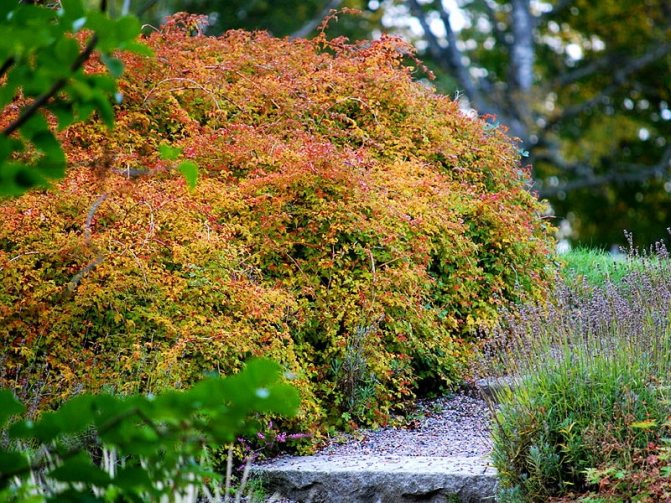

Comprehensive care for Stephanandra
In order for Stephanandra to decorate the site from early spring to late autumn, you need to take care of her carefully. Nursing consists of several areas:
- Watering. Stefanandra is a moisture-loving plant, but in moderation. With excessive watering, the roots can rot, which, accordingly, will lead to its death. But the deficiency also has a detrimental effect on the shrub, so it is necessary to observe it. If its leaves are slightly lowered, an extraordinary watering should be carried out immediately. In general, each bush requires several buckets, every day. But, depending on weather conditions, the procedure can be carried out once every 2 days. Before each watering, experienced gardeners inspect the soil at the root - it should have time to dry out from the previous time. If possible, watering is best done with rainwater or settled water in the evening. In especially dry summers, spraying of the crown is also carried out.
- Loosening of soil and removal of weeds. As already mentioned, Stefanandra loves loose soils.Therefore, if you do not pay attention to mulching with organic matter, then it is necessary to carry out regular loosening, to a depth of at least 10 cm, but so as not to damage the roots. Naturally, in this case, weeds are also removed, which quite actively attack the plant. Until the plant has grown, the weeds must be monitored almost daily.
- Mulching. This method of maintenance helps to retain moisture in the soil, and also prevents the active growth of weeds. Therefore, it is worth mulching the ground around the trunk, this is done with the help of peat to a height of 10 cm. If Stephanandra grows in sunny areas, then mulching is highly desirable.
- Pruning. This procedure is carried out annually every spring after the snow has melted and gardening work has begun. But for the first 3 years, the bush is not touched in this regard. Only for 4 or even 5 years does Stephanandra require sanitary pruning. Dried, broken shoots that have not survived the winter are pruned. It is imperative to cut them off without regret - the shrub will regain its shape in record time.
- Formation. Formative pruning is carried out not for sanitary purposes, but to give the bush the desired shape. At the same time, both excessive thickening and dried rods inside the stefanandra, which appear from a lack of light, are removed. They also monitor the overgrowth, which is excessively formed from lateral shoots, spoiling the appearance of the shrub.
- Top dressing. Most often, plant feeding begins to be used only in the 3rd year of its existence.
- Contributes to the active growth of shrubs and abundant flowering, fertilizing with complex organic fertilizers, but they are best used in the autumn period.
- During the summer, it is necessary to carry out one feeding with a mullein, before that, dilute it in water as 1/10. Can be used as watering.
- Once a season, Stefanandra is fed with humus. One bucket is enough, which must be brought into the soil near the trunk. Best applied while loosening, shallow.
- In early spring, for better plant growth, you can feed it with nitrogen-containing fertilizers - nettle infusion, bird droppings solution. Organic feeding is carried out no more than once a year. The infusion is prepared in advance: chicken manure is diluted in water as 1/10. The infusion is ready only after a week, it is poured directly into the root. Quantity: 1 root - 12 liters. The plant needs such feeding in early spring, immediately the next year after planting.
- Once a month, Stephanander needs to be watered with the following solution: in a bucket of water we dilute 1 liter of mullein, 0.5 cups of wood ash.
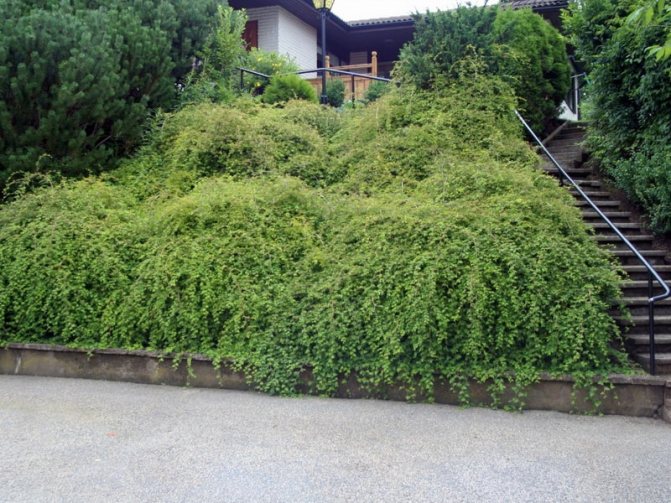

With the onset of cold weather, young stefanandra bushes need to be covered, you just can't leave it, although it is frost-resistant enough, it is not afraid of short-term frosts, reaching 25 degrees. The shoots of the bush are bent to the ground, fixed, and then covered with spruce branches, peat, snow. In the spring, they must be freed from shelter, special attention must be paid to the root collar.
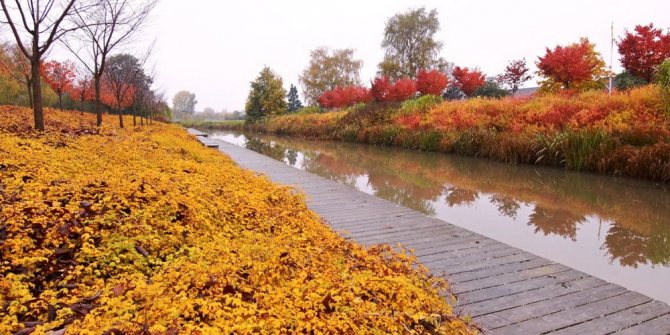

Stephanandra ornamental shrub in landscape design
The shrub is very decorative all season, but it is especially good in autumn, when the foliage turns yellow, pink and even red. This play of colors looks good against the background of conifers and evergreen shrubs (such as boxwood, euonymus, hebe).
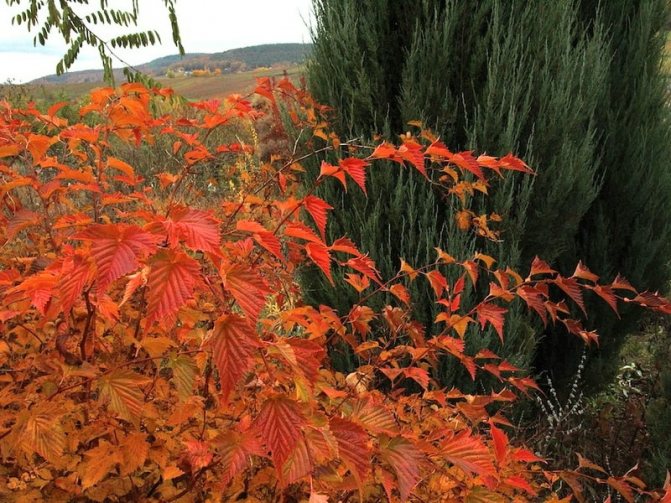

Creeping varieties look great on retaining walls and as ground covers.
Erect species and varieties are used to form hedges.
How to protect Stefanandra from diseases and pests in gardening?
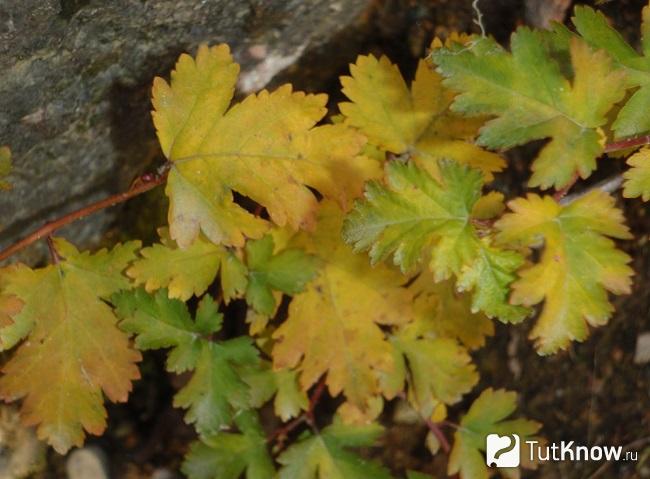

If we talk about the resistance of shrubs "male wreath", then they are practically not susceptible to attacks by pests and diseases. Only if the rules of agricultural technology are regularly violated, then we can expect the appearance of problems of fungal origin:
- Powdery mildew,
which is called linen or ashtray.The disease is manifested by the appearance of whitish stains on the foliage, which gradually begin to cover the entire surface of the leaf plate. Such a plaque, reminiscent of hardened lime, becomes the reason for the cessation of photosynthesis, and the foliage gradually begins to die off. If no action is taken for treatment, then Stefanandra will simply die. - Rust,
also having a fungal etymology and is well defined due to the fact that cushion-shaped growths are formed on the leaves, which, scattering, cover everything around with red dust (which is why the name of the disease has gone). Stefanandra's leaves also lose their color and without even waiting for autumn they turn yellow and fly around. - Gray rot
a disease from the same group is generated by fungal spores. At the same time, the stems become soft, the foliage becomes covered with a fluffy grayish bloom, turns yellow and falls off, the buds, if they appear, have a deformed shape, the stems in the root zone of the stephanandra bush have a circular grayish coating and soften.
All of the above problems arise from too dense soil that does not dry out from moisture, improper irrigation regime, frequent rains at high ambient temperatures. For treatment, it is recommended to remove all damaged parts of the "male wreath" shrub and then treat the plant with fungicidal preparations such as Fundazol, Topsin or Bordeaux liquid.
The lack of moisture is also a problem when growing Stephanandra, then the deciduous mass acquires an out-of-season yellow color, but this sign is also inherent in the stagnation of water in the soil. Then the root system is affected - it rots, the leaves of the bush turn yellow and it dies. If the damage is too severe, it is recommended to remove the diseased plant from the soil and burn it. The soil where it grew is treated with a strong solution of potassium permanganate.
Nutrient dressing and soil fertilization
In order for the plant to please with its lush crown, it needs to be fertilized. It is best to carry out this process with the onset of warmth (March-April). For these purposes, use humus, herbal or dung infusion.
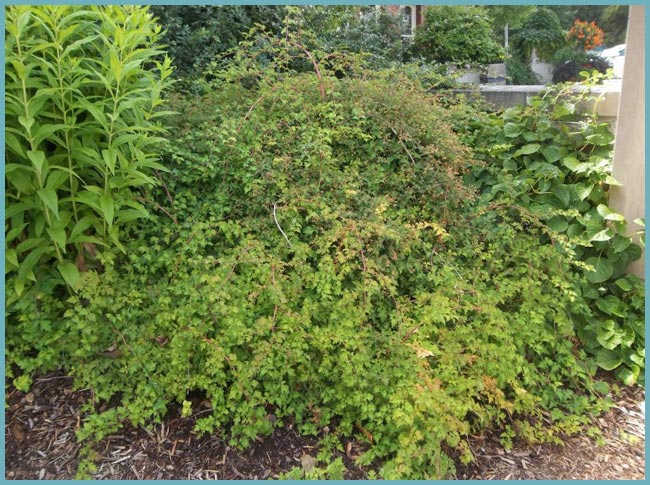

Fertilize the bush once a year - in the spring
Humus is introduced into the trunk circle at a shallow depth (the calculation of the mixture is 1 bucket per 1 shrub), and the infusion is poured under the root, it is prepared in advance, so this is a more troublesome task.
Important! Organic feeding: mix 1 part chicken manure and 10 parts water. The mixture is infused for 7-10 days, then stirred and poured under the root of each bush.
Landing
It is advisable to spend it in the spring, and if the plant is containerized. even in summer, if only she had time to get accustomed to winter. A shallow pit for stephaandra, 40x40 cm in size, is filled with any drainage with a layer of 10 cm. The soil is desirable neutral, for this, when planting, you can put a glass of ash or spill the soil with dolomite. If the soil is clay, it is better to add sand, ready-made compost.
The place can be as sunny. and not very shaded. The main thing is to be protected from strong winds.
Stephanandra looks very beautiful as falling branches to the shore of a pond, or on some elevation to emphasize this property of her green carved waterfall.
Photos by the pond:
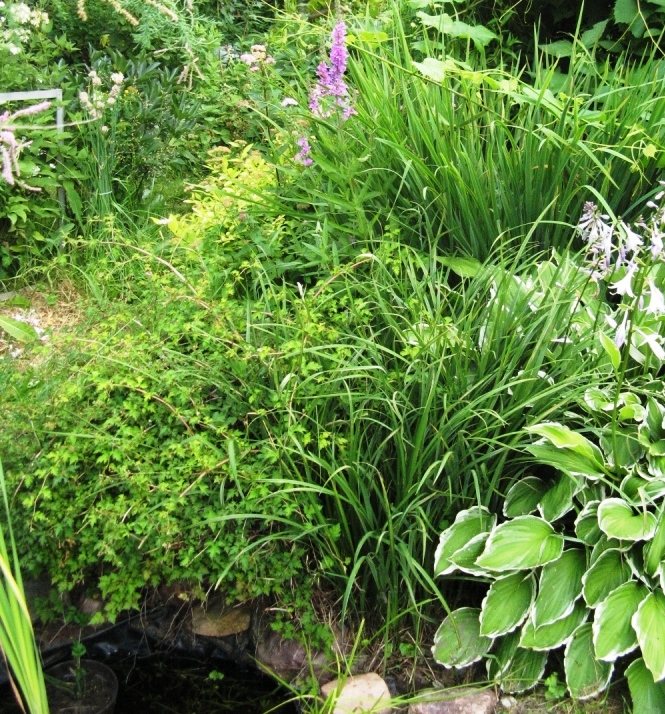

Where can one buy
| Nursery | The cost | grade |
| Lead a nursery Moscow region | 280r | Tanaki 30-40cm |
| Nivaki - nursery for nivaki, topiary and Far Eastern forms Moscow region | 420r | Incised 20-30cm |
| Kennel "Gavrish" Krasnodar region | 170 rub | Incised 40-50cm |
| Architectural and landscape, OOO Nizhny Novgorod Region | 200 rub | Groundcover dwarf. Height 0.3-0.6 m, width up to 1.5 m. |
| Agro, OOO Moscow region | 180 rub | Tanaki 40cm |
| Euro-Plant Leningrad region | 290r | Tanaki |
TaggedStefanandra
recommend
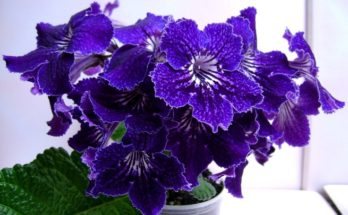

Growing Streptocarpus
November 3, 2019November 3, 2019
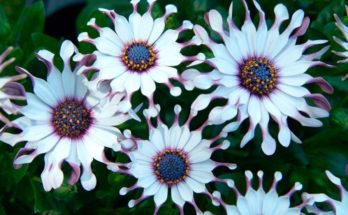

Osteospermum: growing
September 25, 2019September 25, 2019
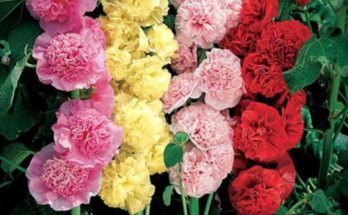

Growing a rose stock
July 31, 2019
New
Growing azaleas: care rules
November 27, 2019
Growing cotton
November 15, 2019
Growing Streptocarpus
November 3, 2019November 3, 2019
Mulard: growing
October 21, 2019October 21, 2019
Growing cyclamen
October 6, 2019
Osteospermum: growing
September 25, 2019September 25, 2019
Growing bells
September 5, 2019September 5, 2019
Diplomas - Growing
August 21, 2019
Growing cannabis
August 14, 2019
Growing cucumbers on the balcony
August 8, 2019August 8, 2019
Growing a rose stock
July 31, 2019
Cucumbers in a barrel growing
July 24, 2019
Growing hosts
July 17, 2019July 17, 2019
Eustoma growing conditions
July 10, 2019July 10, 2019
Picking tomatoes
July 4, 2019July 4, 2019
Tags
apricot watermelon eggplant broccoli spring grapes cherry pests lawn peas hydrangea pear fence winter zucchini cannes cabbage potatoes strawberries rabbits corn chickens onions raspberries carrots cucumbers cucumbers orchid autumn greenhouse pepper watering a pond bees seedling garlands beets plum greenhouse tomato tomatoes pumpkin forsythia
Random post
Wonderful indoor palm tree washingtonia, how to grow from seeds Newbie pink - an old friend in new clothes Drawings of a polycarbonate greenhouse with your own hands from a profile pipe Characteristics, advantages, features of growing a hybrid tomato variety "Kostroma" How to feed carrots after germination How to plant radishes in the ground Celery varieties root and petiole The best varieties of sweet raspberries for the Urals and Siberia
Diseases to be on the lookout for
Stefanandra is a plant with strong immunity. If you competently care for the shrub and create optimal conditions for its development and growth, then most likely, acquaintance with insects will not happen. But the weather sometimes makes its own adjustments: pests can attack the plant under unfavorable atmospheric conditions or due to a violation of the irrigation schedule. You may encounter:
- rust;
- powdery mildew;
- gray rot.
If symptoms of any of these diseases are found, it is necessary to cut off the shoots that were affected first, and carry out a treatment treatment with any suitable fungicidal preparation.
If Stefanandra's leaves turn yellow, this most often indicates that the plant is thirsty, and you either do not water it at all, or water it, but not enough. True, it is important here not to flood the bush. After all, if the water stays at the roots for a long time, they can rot. Ultimately, the plant will have to be uprooted and burned, and the garden plot will have to be treated with disinfectants so that the infection, God forbid, does not spread to other representatives of the summer cottage flora.
Pest and disease control
Stefanandra is extremely resistant to insect pests. Only in rare cases does this plant suffer from diseases such as gray rot, rust, powdery mildew. At the first signs of such diseases, and they appear in the form of yellowing of the foliage, the appearance of black spots on the leaves and shoots, it is necessary to treat shrubs with fungicidal preparations.
The prevention of the appearance of infectious and bacterial diseases will be the provision of proper plant care. In particular, it is necessary to prevent thickening of plantings, plant bushes at the correct distance from each other, timely water and fertilize regularly.
Stefanandra is a decorative, undemanding shrub that will become a real decoration of every personal plot. Planting plants can be done with self-harvested cuttings or seeds, which can be easily purchased at gardening stores. Subsequently, the plants will require regular watering, fertilization and timely pruning, which prevents thickening and forms the correct crown.
Plant shape
In the wild, there are three main types of stefanandra: notched-leaved, tanaki, and Chinese. All these plants look quite impressive. However, only the first two varieties of shrubs are suitable for decorating yards and gardens in Russia. The Chinese stefanandra, unfortunately, is not frost-resistant. Notched-leaved and tanaki tolerate even the most severe winters relatively well. And in care, these two species are quite unpretentious.
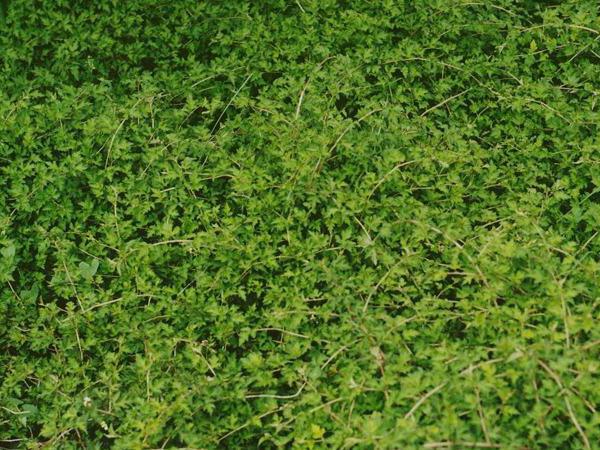

Actually, Stefanandra itself is incised, in turn, is also divided into two types. If desired, you can grow the usual form of this shrub or dwarf in the garden. Outwardly, these two varieties are practically no different. But the dwarf stefanandra, of course, is much shorter than usual.
Pruning and replanting
In the spring and autumn, they carry out obligatory pruning of the shrub. After the snow melts, all diseased and dry branches should be cut off. At the same time, a bush crown is formed. It is imperative to remove shoots that thicken the crown, as they make the appearance of the shrub sloppy (Figure 4).


Figure 4. By pruning, you can form a flat hedge from a shrub
As for the transplant of Stefanandra, it is recommended to grow it immediately in a permanent place. Despite the fact that the culture normally tolerates the change of placement, this can further slow down the already not rapid growth of the shrub.
Landing features
Lighting
The plant prefers lighted places, loves the sun. If the bush is planted in partial shade or shade, it will grow slowly and is unlikely to bloom. In order not to transplant the shrub later, it is recommended to immediately choose a sunny place.
It is important to remember that the plant is afraid of drafts and strong winds. This must be taken into account when choosing a landing site, avoiding open areas.
The soil
Stefanandra loves moist, loose and fertile soil. It can be sandy-peat soil, clay or loamy mixtures. Sand and peat will need to be added to clay soil. Soil acidity is recommended neutral or weak. Drainage is certainly used. For this, gravel, pebbles, large crushed stone or broken brick are suitable.
Landing
To plant young stefanandra seedlings, you need to act in stages:
- Dig a hole in the chosen place about 60 cm x 60 cm;
- Pour drainage into the bottom of the hole;
- Pour sand, layer 10-15 cm;
- Pour in part of the soil mixture (sand, deciduous humus, organic fertilizers);
- Place the bush in the hole and cover with the remaining soil;
- Sprinkle with plenty of water.
Where to plant the plant?
Next, we select a place for Stephanandra in the garden.
Light or shadow?
Stefanandra thrives in sunlit places. Planting in partial shade and even in the shade is also permissible, but in this case the bush will grow slowly, and the inflorescences may not bloom. So that you do not have to replant the plant, initially select a well-sunny plot of land.
The soil
The soil for planting Stefanandra should be fertile, loose, moist. Pick up loose sandy-peat substrates. Planting in loamy or clay mixtures is also possible. Mix heavy clay soil with sand and peat. The acidity of the soil should be neutral or slightly acidic. Be sure to take care of good drainage, for this use pebbles, gravel, broken brick or large rubble.
Important! Drainage is especially important if you have heavy clay soil in your garden.
Stephanandra flowers
The main decorative value of this plant, as already mentioned, is the leaves. Stefanandra's flowers are small and rather inconspicuous. However, on the bushes, they are collected in inflorescences, so they also look quite impressive and unusual. The smell of the flowers of this decorative culture is quite pronounced and very pleasant. The buds bloom in late May or early June.Stefanandra blooms for a month.
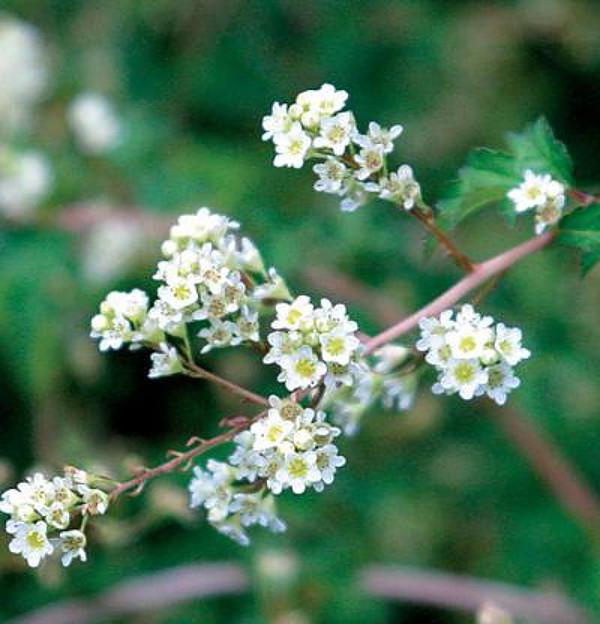

Application in landscape design
The designers liked the ornamental plant and they are happy to dilute gardens, alleys, parks, etc. with it. What can you combine Stefanandra with ?:
- decorate foregrounds for lining trees and shrubs;
- used to decorate the lawn;
- separate the shores of reservoirs, enclose the slopes;
- combine with such plants as Cossack juniper, mountain pine;
- planted surrounded by historical stones, stone statues;
- decorate curbs, paths, stairs;
- planted along the fence, in summer cottages.
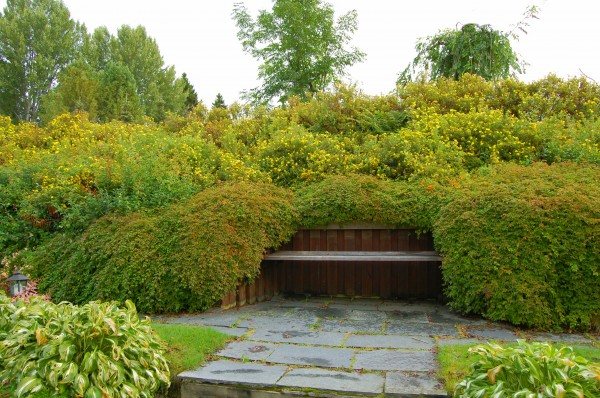

A bench, comfortably framed by the stefanandra bushes.
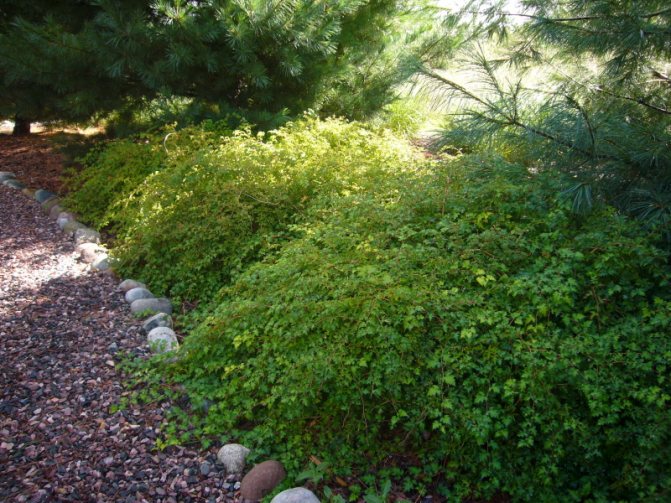

Stefanandra along the path.
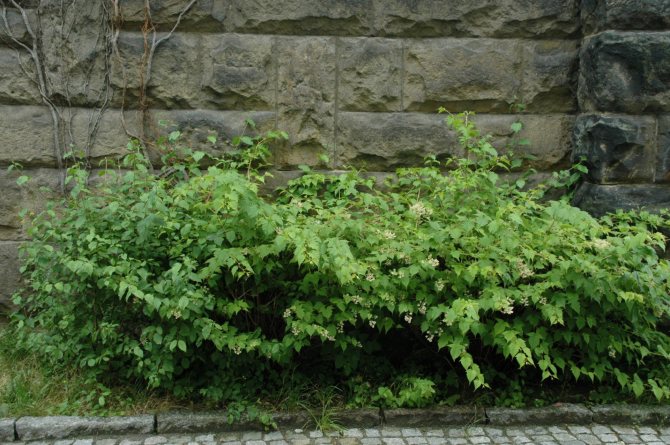

In the shadow of a blank fence.
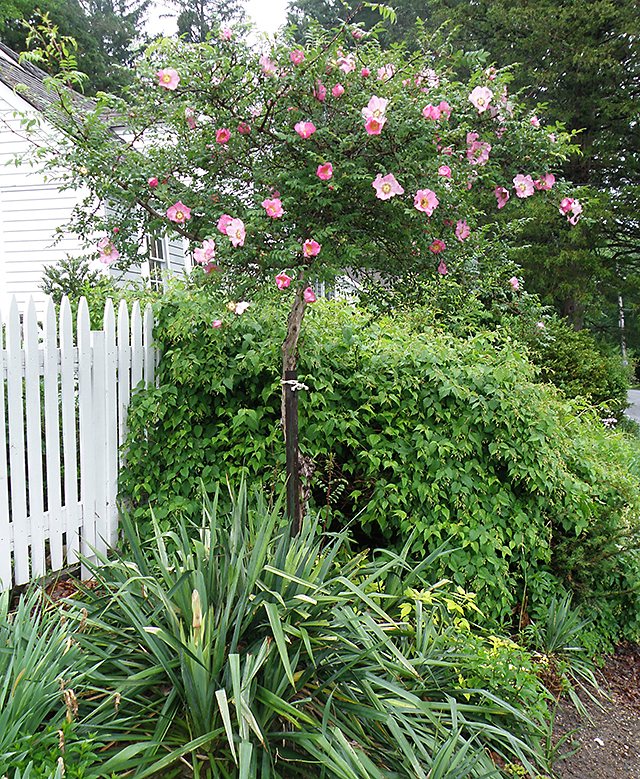

As a background for a standard wrinkled rose.
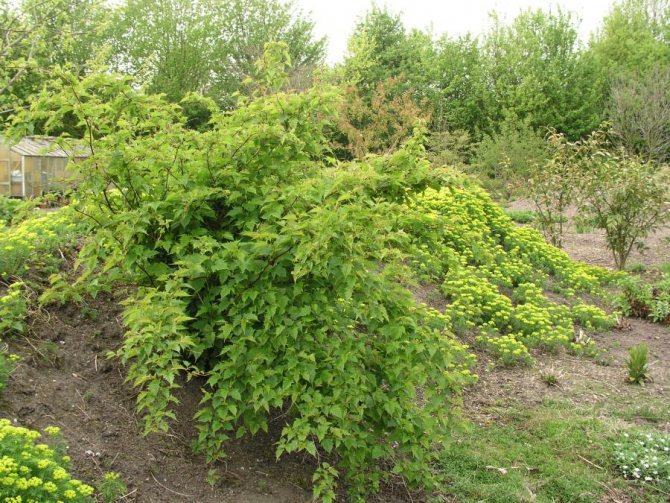

In the springtime, this area is enlivened by flowering irises, which look great next to the graceful appearance of Stefanandra.
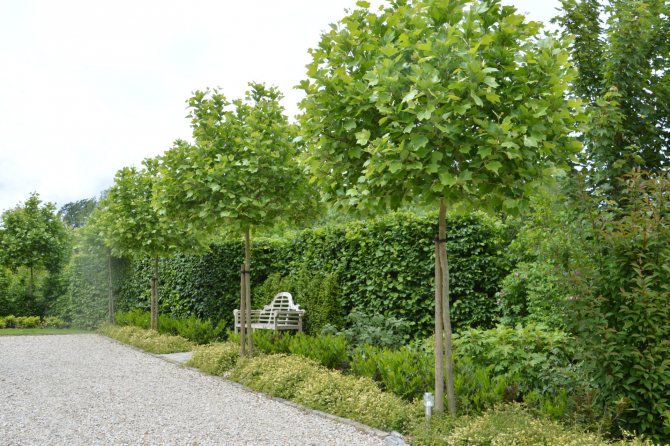

Maple-leaved plane tree 'Alphen's Globe', Stephanandra Crispus, Otto's cherry laurel.
How to water
Ease of cultivation - this is what distinguishes Stefanandra notched-leaved. Planting and caring for her are relatively simple procedures. However, this plant still has one small drawback. Unfortunately, Stephanandra is a very moisture-loving shrub. Perhaps that is why this decorative culture did not gain much popularity among Russian gardeners. After all, for example, the same lilac, mountain ash or bird cherry is not necessary to water even in the driest years. The soil under Stephanandra has to be moistened in the summer in the absence of precipitation every other day. It is not necessary to water the plants too abundantly. Two buckets of water will be enough for one bush. Towards autumn, watering is gradually reduced to two, and then to once a week.
Biological characteristic
Description of Stephanandra: a deciduous shrub of the Rosaceae family, numbering four species in its genus, two of which are also cultivated in our country. The homeland of this plant is East Asia - the Korean Peninsula and the islands of Japan.
The Stephanander shrub is characterized by long, twisting shoots with decorative leaves and small flowers, collected in compact clusters at the ends of the shoots. The structure of the buds makes this plant related to fruit: apple, pear, cherry and decorative: roses and spireas.
The branches of the plant are reddish, they add decorativeness to both green summer leaves and yellow or red autumn leaves. Red openwork shoots also look original in winter against a background of white snow.

